BH: Emma, what hit me when I first came across your work, and I’m thinking the in situ installation pieces, was the strength of the color and forms you had used. And then there was that space – never completely adding up while offering a convincing cohort with the architectural elements that you chose to work with.
EC: For the last 3 or 4 years, I have been working on these large-scale, what I call, spatial deconstruction works, which is really a marriage of my painting practice and this idea of using architectural space as a medium. I use a fairly restricted palate across my practice which allows me to respond to any given structure and space that I’m working with through a set of rules. Each spatial deconstruction has a number and I’m up to number 16 (#16) in the series, which I’ve just completed in Sydney at PALMER art projects for my current show, trace patterns.
BH: So the spatial deconstruction works came out of your painting practice?
EC: Yes, the deconstruction works came out of my two-dimensional painting practice, and for a long time (before that) I just painted. My painting practice was predominantly gestural abstraction, although it had been moving towards more geometric and harder forms for a few years prior. So when I went back and did my masters at Victoria College of the Arts I had this project in my mind about what I wanted to do. The first spatial deconstruction that we are looking at there was an experiment, I suppose, or the ‘break through’ work. I had this space to use and it was a pretty intuitive process in creating the work, in that I didn’t do any sketches or have an idea of exactly what I wanted to do before I made this first spatial deconstruction work. I just created it quite instinctively, much like the process I was using at the time to create an abstract painting. Although I would have to say that my methods are much more predetermined and exacting now.
 BH: So it’s not like you were imposing your will on the physical space?
BH: So it’s not like you were imposing your will on the physical space?
EC: Well, I was working with the architectural space and responding to what I felt it needed. In that sense, I was just drawing in space with paint while creating a three-dimensional painting that seemed to make sense to me. It’s not dissimilar to the process of how I would apply paint to a canvas. However, with the three-dimensional work there is a more restricted palette and process of logic, where decisions need to be able to be rationalized in relation to the architectural space.
BH: With site specific work there has to be a clear idea there somewhere, otherwise it can get pretty unwieldly.
EC: Site specificity is such a broad term, so I guess what I’m really wanting to say is that all decisions are based upon my broader practice and how I respond to the specific intervention.
One of my favorite essays is Rosalind Krauss’s, Sculpture in the Expanded Field, and while it was written almost 40 years ago, I guess I still see a relationship with the work I am making now to this seminal time, the idea of interactivity, where the architectural elements become part of the sculpture is definitely an idea I’m interested in. I’m also definitely imposing my practice in creating a site specific work. It’s my language of color and geometry and how I suppose I imagine it should interact with the space.
BH: Spatial deconstruction #4, in a sense, reads simpler, but also is a braver intervention bringing into the challenge that dip in the ceiling.
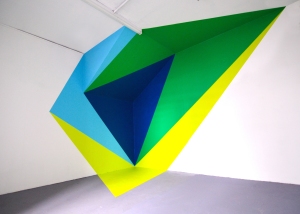 EC: That’s actually the stairs behind there. And, yes, there is also a more restricted color palate.
EC: That’s actually the stairs behind there. And, yes, there is also a more restricted color palate.
BH: The restriction isn’t really a restriction as color sits differently on each plane, so you have that to play with.
EC: Yeah, that’s the benefit of working with actual space as opposed to working with an autonomous object, or a flat canvas.
BH: And the lighting fixture up there. What happens when you turn that on?
EC: It’s a fluorescent and it’s not intended to be turned on to view the work. I always like to use natural light when I can. Otherwise, I’m working with a superimposed light which impacts the architectural space, but you work with the parameters you have, as you have to, as natural light is not always available.
BH: Spatial deconstruction #8 seems to coexist in an easier going almost studio environment.
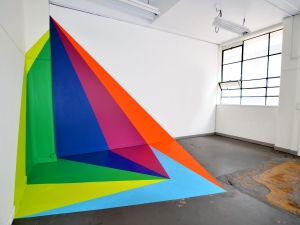 EC: Spatial deconstruction #8 was commissioned by Melbourne Indesign, which is a biannual
EC: Spatial deconstruction #8 was commissioned by Melbourne Indesign, which is a biannual
architectural event. They knew my work and asked me to do this for them. It was located in a unique Art Deco building in the CBD of Melbourne. This was a very interesting project in that I could work quite free and directly with the space and go quite big with the floor intervention, as they weren’t’ worried about painting it back. Often when I’m working there’s a lot of logistical things to consider, such as returning the space back to its former condition. Time frame is also always a big one to consider. I didn’t have the restriction of returning the space back to its former condition, although I think I only had about 1.5 days to install it, so I was in a bit of a panic as that’s a little bit tight! Whereas with the next intervention I did at Hotel Windsor, (spatial deconstruction #9) there had to be a lot more preplanning as the site was heritage with a velvet carpet floor, so obviously I couldn’t just go in and paint.
BH: I notice with the Hotel Windsor piece there is a door there. Where, and on what, is the actual work located?
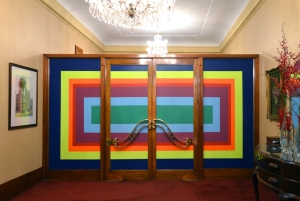 EC: The actual work is on the front of the doors but it was painted in my studio and then carefully adhered to the door. So it appears to be actually painted on the door, but in fact it’s not. I also had only half a day to install it, so I had to come up with a new way of making the work while not impacting the outcome. In that sense there are different restrictions in different environments. So getting back to #8, I was able to paint directly onto the floor and work with the space in a more direct manner.
EC: The actual work is on the front of the doors but it was painted in my studio and then carefully adhered to the door. So it appears to be actually painted on the door, but in fact it’s not. I also had only half a day to install it, so I had to come up with a new way of making the work while not impacting the outcome. In that sense there are different restrictions in different environments. So getting back to #8, I was able to paint directly onto the floor and work with the space in a more direct manner.
BH: With spatial deconstruction # 8, and I guess it’s a painter’s question, you have the orange, purple, green and yellow and when you paint on the wall the underneath color is white, but when you work out onto the floor it’s gray. So do you need to juggle that? To give an example: with the orange, how do you work that so the orange reads continuous on the floor and up on through to the wall?
EC: I just keep working it up until it gets quite opaque, sometimes it can be up to five or six coats. I was just saying today, it was really interesting working with Diana’s space (at PALMER) as it was the first time that I have worked with a white floor, which is a really nice thing. It’s almost like a blank canvas. Usually the floor is gray, or timber or something like that, so I need to consider the whole space quite differently, as it already has a predetermined language.
BH: The piece at Palmer Projects, was that ready to go? I mean, did you do plans before you came into the gallery?
EC: My process, typically, is to go in and document the space, take photographs, spend some time in the space and get a sense of how I think about it – and come up with some different ideas that I think respond to the space. So I have an idea, and then there is a certain amount of pre-planning that has to happen. For example, I need a certain amount of paint, specific quantities of the colors, as well as needing a pretty good idea of the time-frame – how long it will take to make. But also when I go in, there is that flexibility. If I don’t think it’s working, I can go in and change things. I always like for there to be an element of adaptation from the idea to working in actual space. As long as I’ve got enough time I can respond to real-time in the space. With larger pieces I sometimes have someone come in and help me with it, which can get a bit tricky… you know… you have to communicate what you are wanting… so everything has to be more resolved. The tolerance for unresolved decisions is less.
BH: This time you did it pretty much by yourself, right!
EC: Yes that’s more or less right. Scott, one of Diana’s artists came in for a bit on Saturday to help, and Diana herself also helped me to set out the tape, and Leigh her fiancée helped me to set out the floor. There’s certain things like setting out long stretches of tape that are just about impossible to do on your own. I was worried at first about the time, but it worked out fine. It was all good!
BH: Prismatic spatial deconstruction # 11’s spatial illusion and paired down structure/colored areas really take off. I said earlier what confounds your work is that it never really adds up, yet somehow feels right.
EC: Yes, I really thought about this and I really am responding to the parameters of the space, but I’m also making decisions in that I’m imposing what I think needs to go in there.
BH: Spatial deconstruction # 11 has a really solid sense of form tilting over into the void of the white wall. It stops doing that when you notice the adjacent wall with the strip of blue and purple so that the first wall then re-presents itself as being a flat area of colored paint on a flat surface. It goes from feeling like there is this huge form tilting, to returning to the super flat surface it’s painted on, which then flips back again into volume.
EC: Yes, opticality and the illusion of form, these things really just happen through the positioning of two-dimensional paint. I guess this is one of the things I’m wanting to work with – the idea of the architectural space being as important as the art in terms of a hierarchy; and that color and the architectural space can be conceptual concerns and ideas alone.
BH: Well, for me, it reads fresh.
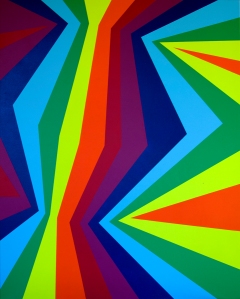 EC: Some people say fresh, then others will say that it really harks back to the 70’s. I guess both are true, in a way. But, yeah, it’s interesting how people approach abstraction in general. I mean, Melbourne is a bit of a figurative town, and then also there are a lot of artists who make installation, and work with found objects and assembly, and then there’s the idea of ‘bad’ painting versus digital painting, and also still a strong focus on video work. I suppose I find I can’t get too caught up in it all. If I think about it for too long it just makes me think that my work doesn’t ‘fit in’. I try to just work with my own ideas. And obviously they have to fit into a purpose within the whole context of art. And whatever you are making always does, but I can’t get too influenced by what’s happening, or by what everyone else is doing, because… you know… I have to drive my own practice.
EC: Some people say fresh, then others will say that it really harks back to the 70’s. I guess both are true, in a way. But, yeah, it’s interesting how people approach abstraction in general. I mean, Melbourne is a bit of a figurative town, and then also there are a lot of artists who make installation, and work with found objects and assembly, and then there’s the idea of ‘bad’ painting versus digital painting, and also still a strong focus on video work. I suppose I find I can’t get too caught up in it all. If I think about it for too long it just makes me think that my work doesn’t ‘fit in’. I try to just work with my own ideas. And obviously they have to fit into a purpose within the whole context of art. And whatever you are making always does, but I can’t get too influenced by what’s happening, or by what everyone else is doing, because… you know… I have to drive my own practice.
BH: So what drew you to making work with such simple colors, and uninfected design?
EC: It’s really interesting because I have a gestural painting background and did that for quite a few years. Color has always had a strong presence within the work. And, I guess, there was always that idea that I wanted to have a language which would define my practice more, so reducing it and being a bit more repetitive with the colors meant not having to reinvent them every time, especially as I was experimenting with actual architectural space.
I have a set of variables to work with each time I go in to manipulate the space; and, as you can imagine, if I was actually using different colors each time it’d just get too much.
BH: You have started working with plexiglass, and I did see your small sculptural piece at Woollahra Council recently, so talking about these acrylic pieces, what actually are they?
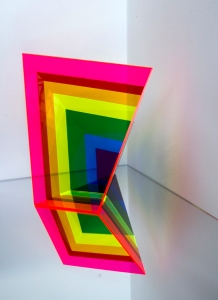 EC: The constructions are colored acrylic glued together and they all sit on a mirrored space so that the reflection becomes part of the work. They come out of a few years of experimenting and thinking about how to do this: the scale is very different, and essentially they are autonomous. The materiality of these small sculptures, which I call ‘constructions’ is quite important, but the aspect of illusion is still paramount.
EC: The constructions are colored acrylic glued together and they all sit on a mirrored space so that the reflection becomes part of the work. They come out of a few years of experimenting and thinking about how to do this: the scale is very different, and essentially they are autonomous. The materiality of these small sculptures, which I call ‘constructions’ is quite important, but the aspect of illusion is still paramount.
BH: I can see that! And it’s interesting that when you photograph these the mirrored reflection appears solid.
EC: It’s quite amazing when you photograph them that that’s what happens. You can almost not tell what is the reflection when they are photographed. The photography of the work is always a really important aspect for me. But at the same time, I don’t consider the photograph as another artwork, even though I am quite meticulous about it.
BH: So you wouldn’t ever think of the photograph as another commercial aspect?
EC: I think that would take my practice in a different direction. It can get problematic even though in the end there is only the photographic documentation of the spatial deconstruction work that continues to exist. So there is that problematic aspect, but it’s a nice problem. I think it was Daniel Buren who said that the photograph of a site specific work could only ever be the souvenir. I guess that’s how I feel too.
BH: With your newer paintings they do respond to the wall works and they do respond to the small sculptures. But they respond differently as you are dealing with a rectangle.
EC: Of course, there has always been that illusion of
two-dimensional space in art, the old idea or problem of producing illusionistic space, or reducing it to a flatplane is what painting has been all about for centuries. ‘Flat paintings’ have always been part of my practice, they are an important anchor point. It can get quite difficult with the three-dimensional painting, the logistics, and the labor and the nature of being ephemeral… I was saying to Diana this morning that I’d love to make a more detailed spatial deconstruction work which had as much detail as one of my two-dimensional paintings, however it would really take a long time… and I’m not sure, maybe it wouldn’t work. Sometimes the simple ideas are the most effective.
BH: With the paintings, let’s say with Conical #4, what you’re saying is that it’s a three-dimensional painting?
EC: Yeah, I’m trying to create that illusion of three-dimensional form, along with using the same kind of jarring of colors. The order of the colors is very important in the perception of the work.
BH: The optical effect is similar to your installation work and sculptures.
EC: Yeah!
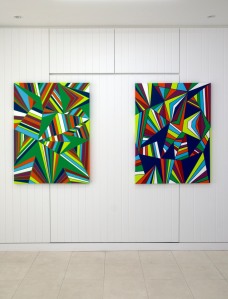 BH: You paint around the edge of the paintings so they are in a sense also sculptural. Is there a reason for that?
BH: You paint around the edge of the paintings so they are in a sense also sculptural. Is there a reason for that?
EC: Yes, I think to complete the work. If I didn’t paint around the edge it would not be completed… it would be wrong. I just feel very strongly about the work being completed with the edges being painted. And, sure, it does create that three-dimensional space, yet not in a way that the sculpture or a wall work does. It’s still a flat rectangle. I call my two-dimensional works, flat paintings.
BH: The smaller so-called improvised geometry paintings seem to be coming out of somewhere different?
EC: They are… they’re a direct response from making the small sculptures. There is more positive and negative space in them, I suppose. And I have added the white, which is quite a big change for me.
BH: In improvised geometry #4 you have the folding forms ‘origami style’ happening. And each area reads like it could easily exist by itself.
EC: I think with these newer works I wanted to push the ideas further, into another area, which, as you know, we are all trying to do as artists. Leading up to making the small constructions (sculptures), I was just working with sketches and drawings and I just got to a point where I knew what I wanted to do, and I knew that it was going to be the next tiny little push. And it is interesting how the different aspects of practice feed off of one another, and move things along.
BH: And I guess these newer paintings are going to impact at some stage your installation pieces?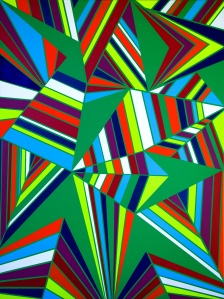
EC: I’m not ready yet to go to that next stage. It’s an interesting question… I’m not sure! Painting in space is very different from painting on a flat surface. I think the geometry, when you are painting in real space, is much simpler than when working on a stretcher. That said, and I was just thinking that this morning, I’d like to take out some of the origami type forms and put them into real space to see how they might work.
BH: I can see that working.
EC: I would probably never use white in the installation work as those are always framed by white. But there are all these little movements in the greater body of work, and even maybe larger constructions are a possibility in future.
BH: All things are possible. Thanks Emma!
EC: Thanks Brent!
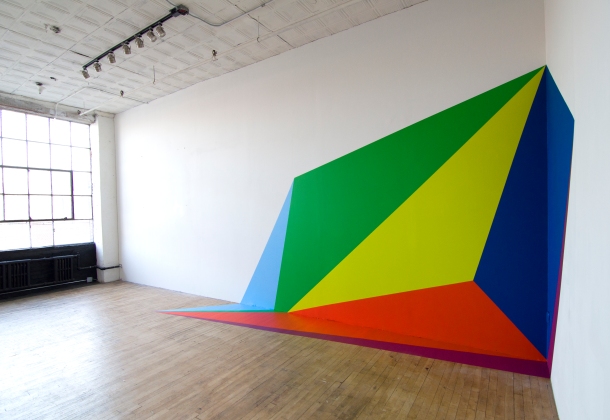
Thanks so much for sharing this post! I had been unaware of this artist – and her work is great. Cheers! Louise P. Sloane >
💪👍❤️❤️